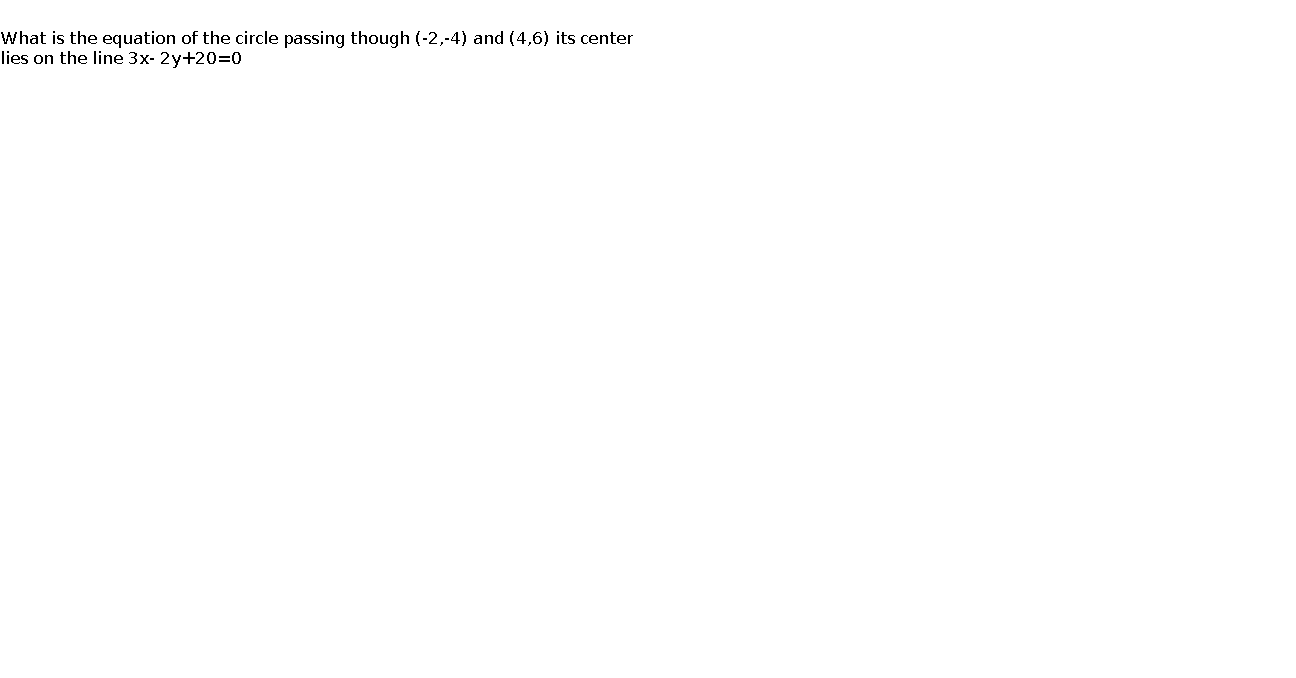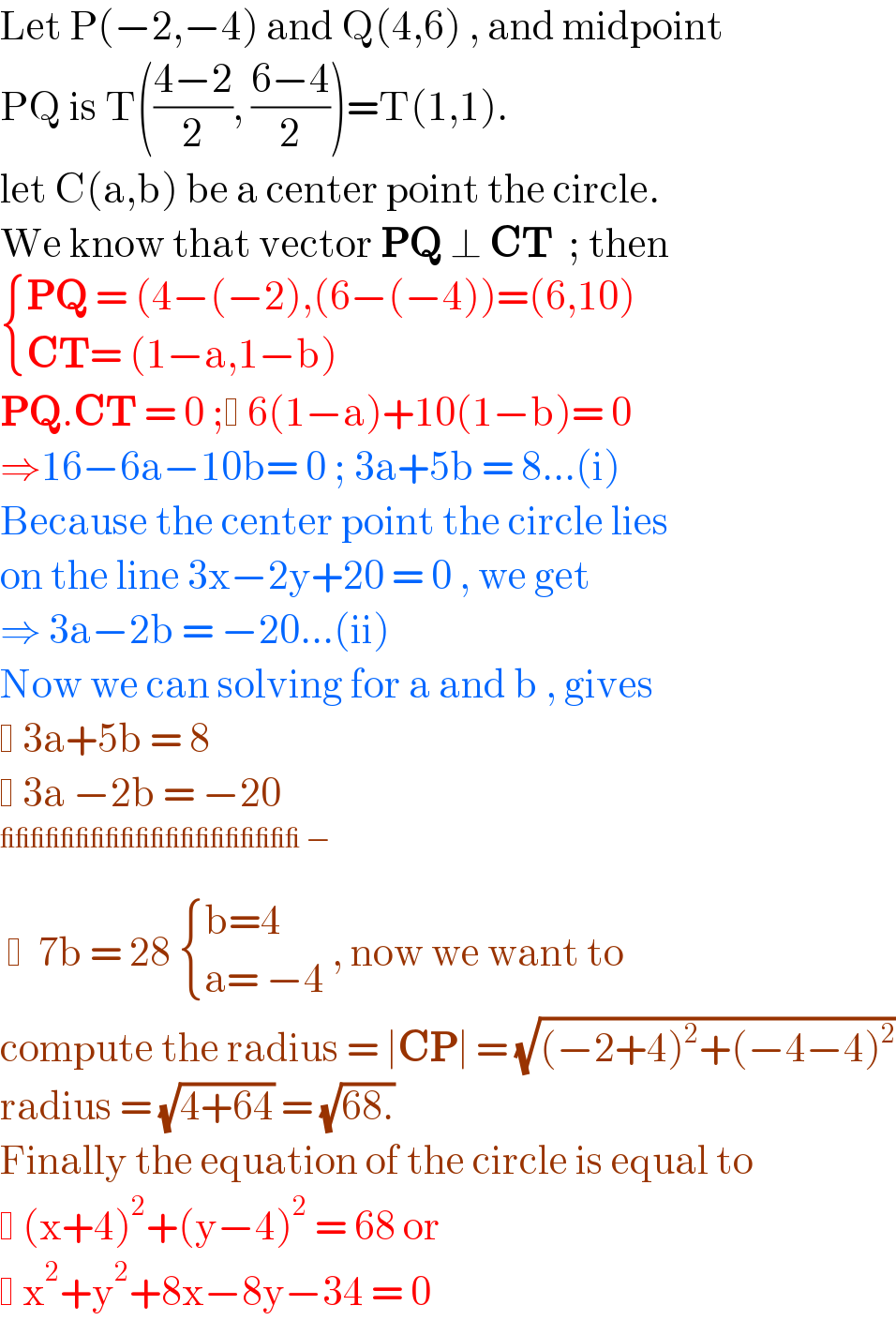Question Number 136781 by bramlexs22 last updated on 25/Mar/21

$$ \\ $$What is the equation of the circle passing though (-2,-4) and (4,6) its center lies on the line 3x- 2y+20=0
Answered by EDWIN88 last updated on 26/Mar/21

$$\mathrm{Let}\:\mathrm{P}\left(−\mathrm{2},−\mathrm{4}\right)\:\mathrm{and}\:\mathrm{Q}\left(\mathrm{4},\mathrm{6}\right)\:,\:\mathrm{and}\:\mathrm{midpoint} \\ $$$$\mathrm{PQ}\:\mathrm{is}\:\mathrm{T}\left(\frac{\mathrm{4}−\mathrm{2}}{\mathrm{2}},\:\frac{\mathrm{6}−\mathrm{4}}{\mathrm{2}}\right)=\mathrm{T}\left(\mathrm{1},\mathrm{1}\right).\: \\ $$$$\mathrm{let}\:\mathrm{C}\left(\mathrm{a},\mathrm{b}\right)\:\mathrm{be}\:\mathrm{a}\:\mathrm{center}\:\mathrm{point}\:\mathrm{the}\:\mathrm{circle}. \\ $$$$\mathrm{We}\:\mathrm{know}\:\mathrm{that}\:\mathrm{vector}\:\boldsymbol{\mathrm{PQ}}\:\bot\:\boldsymbol{\mathrm{CT}}\:\:;\:\mathrm{then} \\ $$$$\begin{cases}{\boldsymbol{\mathrm{PQ}}\:=\:\left(\mathrm{4}−\left(−\mathrm{2}\right),\left(\mathrm{6}−\left(−\mathrm{4}\right)\right)=\left(\mathrm{6},\mathrm{10}\right)\right.}\\{\boldsymbol{\mathrm{CT}}=\:\left(\mathrm{1}−\mathrm{a},\mathrm{1}−\mathrm{b}\right)}\end{cases} \\ $$$$\boldsymbol{\mathrm{PQ}}.\boldsymbol{\mathrm{CT}}\:=\:\mathrm{0}\:; \:\mathrm{6}\left(\mathrm{1}−\mathrm{a}\right)+\mathrm{10}\left(\mathrm{1}−\mathrm{b}\right)=\:\mathrm{0} \\ $$$$\Rightarrow\mathrm{16}−\mathrm{6a}−\mathrm{10b}=\:\mathrm{0}\:;\:\mathrm{3a}+\mathrm{5b}\:=\:\mathrm{8}…\left(\mathrm{i}\right) \\ $$$$\mathrm{Because}\:\mathrm{the}\:\mathrm{center}\:\mathrm{point}\:\mathrm{the}\:\mathrm{circle}\:\mathrm{lies} \\ $$$$\mathrm{on}\:\mathrm{the}\:\mathrm{line}\:\mathrm{3x}−\mathrm{2y}+\mathrm{20}\:=\:\mathrm{0}\:,\:\mathrm{we}\:\mathrm{get}\: \\ $$$$\Rightarrow\:\mathrm{3a}−\mathrm{2b}\:=\:−\mathrm{20}…\left(\mathrm{ii}\right) \\ $$$$\mathrm{Now}\:\mathrm{we}\:\mathrm{can}\:\mathrm{solving}\:\mathrm{for}\:\mathrm{a}\:\mathrm{and}\:\mathrm{b}\:,\:\mathrm{gives} \\ $$$$ \:\mathrm{3a}+\mathrm{5b}\:=\:\mathrm{8} \\ $$$$ \:\mathrm{3a}\:−\mathrm{2b}\:=\:−\mathrm{20} \\ $$$$ \\ $$$$\: \:\:\mathrm{7b}\:=\:\mathrm{28}\:\begin{cases}{\mathrm{b}=\mathrm{4}}\\{\mathrm{a}=\:−\mathrm{4}}\end{cases}\:,\:\mathrm{now}\:\mathrm{we}\:\mathrm{want}\:\mathrm{to} \\ $$$$\mathrm{compute}\:\mathrm{the}\:\mathrm{radius}\:=\:\mid\boldsymbol{\mathrm{CP}}\mid\:=\:\sqrt{\left(−\mathrm{2}+\mathrm{4}\right)^{\mathrm{2}} +\left(−\mathrm{4}−\mathrm{4}\right)^{\mathrm{2}} } \\ $$$$\mathrm{radius}\:=\:\sqrt{\mathrm{4}+\mathrm{64}}\:=\:\sqrt{\mathrm{68}.} \\ $$$$\mathrm{Finally}\:\mathrm{the}\:\mathrm{equation}\:\mathrm{of}\:\mathrm{the}\:\mathrm{circle}\:\mathrm{is}\:\mathrm{equal}\:\mathrm{to} \\ $$$$ \:\left(\mathrm{x}+\mathrm{4}\right)^{\mathrm{2}} +\left(\mathrm{y}−\mathrm{4}\right)^{\mathrm{2}} \:=\:\mathrm{68}\:\mathrm{or}\: \\ $$$$ \:\mathrm{x}^{\mathrm{2}} +\mathrm{y}^{\mathrm{2}} +\mathrm{8x}−\mathrm{8y}−\mathrm{34}\:=\:\mathrm{0} \\ $$
Commented by EDWIN88 last updated on 26/Mar/21

Answered by mr W last updated on 26/Mar/21

$${say}\:{center}\:{of}\:{circle}\:{is}\:\left({u},{v}\right),\:{radius}\:{r} \\ $$$$\mathrm{3}{u}−\mathrm{2}{v}+\mathrm{20}=\mathrm{0}\:\:\:…\left({i}\right) \\ $$$$\left({u}+\mathrm{2}\right)^{\mathrm{2}} +\left({v}+\mathrm{4}\right)^{\mathrm{2}} ={r}^{\mathrm{2}} \:\:\:…\left({ii}\right) \\ $$$$\left({u}−\mathrm{4}\right)^{\mathrm{2}} +\left({v}−\mathrm{6}\right)^{\mathrm{2}} ={r}^{\mathrm{2}} \:\:\:…\left({iii}\right) \\ $$$$\left({ii}\right)−\left({iii}\right): \\ $$$$\mathrm{3}{u}+\mathrm{5}{v}−\mathrm{8}=\mathrm{0}\:\:\:…\left({iv}\right) \\ $$$$\left({iv}\right)−\left({i}\right): \\ $$$$\mathrm{7}{v}−\mathrm{28}=\mathrm{0}\:\Rightarrow{v}=\mathrm{4} \\ $$$${u}=\frac{\mathrm{8}−\mathrm{5}{v}}{\mathrm{3}}=\frac{\mathrm{8}−\mathrm{20}}{\mathrm{3}}=−\mathrm{4} \\ $$$${r}^{\mathrm{2}} =\left(−\mathrm{4}+\mathrm{2}\right)^{\mathrm{2}} +\left(\mathrm{4}+\mathrm{4}\right)^{\mathrm{2}} =\mathrm{68} \\ $$$${eqn}.\:{of}\:{circle}: \\ $$$$\left({x}+\mathrm{4}\right)^{\mathrm{2}} +\left({y}−\mathrm{4}\right)^{\mathrm{2}} =\mathrm{68} \\ $$
Commented by otchereabdullai@gmail.com last updated on 27/Mar/21

$$\mathrm{nice}! \\ $$
